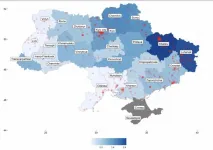A lifesaving chain, a global first: Penn Medicine sets a worldwide record with 100 kidney paired donation transplants in a year
The Penn Transplant Institute sets record for the most Kidney Paired Donation transplants in a 12 month period
2023-12-12
(Press-News.org) PHILADELPHIA— For thousands of people around the world waiting for a kidney, paired exchange serves as a beacon of hope. One person's willingness to undergo the act of Kidney Paired Donation (KPD) often sets in motion a chain of beautiful and selfless acts, where individuals give and receive the chance for a better life. After completing its 100th KPD transplant in a 12 month period, the Penn Transplant Institute now holds the world-wide record for the most KPD transplants in a year.
More than 90,000 people in the United States are waiting to receive a kidney transplant, with average waits to receive a kidney from a deceased donor stretching to between five and eight years. Those on the list must receive regular dialysis to stand in for their failed kidneys, and 4,000 people in the U.S. die each year waiting to receive a transplant.
Coordinated through the National Kidney Registry (NKR), paired exchange helps those in need of a kidney transplant who have a willing but poorly compatible or incompatible living donor – for instance, a friend or a sibling who is not a match to donate to their loved one but is nonetheless motivated to become part of an exchange. In a traditional kidney transplant scenario, that living donor would donate a kidney to their own loved one. However, sometimes the donor and recipient are poorly compatible or not compatible due to genetics. Paired exchange gives them another chance to help both their loved one and others, expanding the pool of potential donors and recipients.
Penn Medicine’s 100th paired kidney exchange surgery over the past 12 months, completed on December 6th, represents a significant milestone not only for Penn Medicine but for the broader transplant community. “This achievement reflects not only our dedication to excellence in patient care but also the innovative spirit that defines Penn Medicine. By embracing the potential of paired exchange, we are providing renewed hope to those in need,” said Amanda Leonberg-Yoo, MD, an assistant professor of Renal-Electrolyte and Hypertension and medical director of the Kidney Living Donor Program. “This milestone wouldn’t be possible without the countless number of people who make the choice to donate a kidney to a loved one, neighbor, or sometimes even complete stranger. Their selfless act of generosity often inspires others to do the same.”
In December of 2022, Penn launched its Center for Living Donation. Based at the Hospital of the University of Pennsylvania, the Center for Living Donation expanded the Penn Transplant Institute’s team of experts, to provide more valuable resources for transplant recipients and donors, like mentors who have gone through the living donation process themselves, who can be a reassuring voice through the transplant journey.
Penn Medicine performed its first kidney transplant in 1966. Since that time, its transplant program has grown into a powerhouse multidisciplinary team of transplant surgeons, nephrologists, nurses, and professionals in fields from social work to pharmacy and nutrition to physical therapy who work tirelessly to orchestrate these intricate exchanges every day. Their commitment to advancing medical science and improving patient outcomes has made Penn Medicine a leader in the field of organ transplantation.
The NKR works to identify and connect compatible, well-matched donor-patient pairs from the largest living donor pool in the world. “Anyone who is involved in paired exchange will understand the magnitude of Penn’s accomplishment in completing a staggering 100 KPD transplants in a 12-month period. This will be like Roger Bannister breaking the 4 minute mile barrier – Penn proved it is possible and now many transplant centers will break the 100 KPD transplant threshold over the next decade, facilitating thousands of additional life-saving living donor kidney transplants.” said Garet Hil, Founder and Chief Executive Officer of the National Kidney Registry and a living kidney donor. Those interested in learning more about the living kidney donation process can do so through NKR, or Penn’s Center for Living Donation.
###
Penn Medicine is one of the world’s leading academic medical centers, dedicated to the related missions of medical education, biomedical research, excellence in patient care, and community service. The organization consists of the University of Pennsylvania Health System and Penn’s Raymond and Ruth Perelman School of Medicine, founded in 1765 as the nation’s first medical school.
The Perelman School of Medicine is consistently among the nation's top recipients of funding from the National Institutes of Health, with $550 million awarded in the 2022 fiscal year. Home to a proud history of “firsts” in medicine, Penn Medicine teams have pioneered discoveries and innovations that have shaped modern medicine, including recent breakthroughs such as CAR T cell therapy for cancer and the mRNA technology used in COVID-19 vaccines.
The University of Pennsylvania Health System’s patient care facilities stretch from the Susquehanna River in Pennsylvania to the New Jersey shore. These include the Hospital of the University of Pennsylvania, Penn Presbyterian Medical Center, Chester County Hospital, Lancaster General Health, Penn Medicine Princeton Health, and Pennsylvania Hospital—the nation’s first hospital, founded in 1751. Additional facilities and enterprises include Good Shepherd Penn Partners, Penn Medicine at Home, Lancaster Behavioral Health Hospital, and Princeton House Behavioral Health, among others.
Penn Medicine is an $11.1 billion enterprise powered by more than 49,000 talented faculty and staff.
END
ELSE PRESS RELEASES FROM THIS DATE:
2023-12-12
University of Virginia School of Medicine researchers have created an “atlas of atherosclerosis” that reveals, at the level of individual cells, critical processes responsible for forming the harmful plaque buildup that causes heart attacks, strokes and coronary artery disease.
Atherosclerosis, or hardening of the arteries, affects half of Americans between ages 45 and 84, and many don’t even know it, the National Institutes of Health reports. Over time, fatty plaques build up inside the arteries, where they can slow blood flow. When they break loose, they can be deadly, triggering strokes and heart attacks.
Doctors ...
2023-12-12
In a Perspective, researchers call for equity in cannabis research as the field rapidly expands. When marijuana was illegal across the United States, enforcement and penalties were disproportionately heaped upon communities of color. Today, cannabis remains federally illegal and unequal enforcement continues, while profits from the “green rush” of state legalization are in many cases flowing to wealthy white men. Renée Martin-Willett and an interdisciplinary team of colleagues propose a way forward for cannabis research that acknowledges this history of discrimination and misuse of institutional power and embraces ...
2023-12-12
During the all-out invasion of Ukraine, Russia has deliberately chosen civilian targets, such as apartment buildings, presumably with the goal of deterring Ukrainian resistance. But does such terror deter or, in contrast, motivate resistance among ordinary Ukrainians? Henrikas Bartusevičius and colleagues conducted two-wave probability surveys in Ukraine in March and April 2022, with approximately 1,000 and 800 respondents in the first and second waves, respectively. Surveys were conducted online by a local survey agency, Info Sapiens. Respondents reported the frequency of ...
2023-12-12
When a severe drought hit California in 1977, the state ordered citizens to drastically reduce domestic water usage. Water restrictions put in place occurred after a heady mix of prosperity and radical urban planning had resulted in the construction of more than 150,000 private swimming pools in California in the 1960s. The result was a ubiquitous new landscape feature: empty concrete pools. Ulf Büntgen and colleagues document how this novel geographic resource inspired surfers to develop professional vertical skateboarding in Los Angeles and environs. Other causal factors included the development of polyurethane ...
2023-12-12
Why did professional skateboarding arise in southern California in the 1970s? Was it a coincidence, or was it a perfect storm of multiple factors?
It’s fairly well-known that a drought in southern California in the mid-1970s led to a ban on filling backyard swimming pools, and these empty pools became playgrounds for freestyle skateboarders in the greater Los Angeles area. But a new cross-disciplinary study from the University of Cambridge shows that beyond the drought, it was the entanglement of environmental, economic and technological factors that led to the explosive rise of professional skateboarding culture in the 1970s.
The authors say that professional ...
2023-12-12
It may soon be time to wake up and smell the lab-grown coffee made from cultured plant cells. But it’s not clear whether drinks from this product replicate coffee beans’ complex flavors. Now, a study in ACS’ Journal of Agricultural and Food Chemistry found that some of the comforting aromas and tastes of a conventional cup of coffee could be reproduced by roasting and brewing coffee cell cultures.
Coffee is one of the most popular beverages worldwide. According to the U.S. Department of Agriculture, 23 billion pounds of beans are expected to be produced during the 2023–24 growing ...
2023-12-12
In a Perspective, a biophysical chemist, Kenneth J. Breslauer, and his brother, a political scientist, George W. Breslauer, explore the parallelisms between the concept of stability as it is used in their respective fields. The workings of a cell or molecule are generally understood to be reducible to physics, but social and political events are thought to be structured by human agency and a generous helping of chance. However, both molecular systems and socio-political organizations can be said to exhibit stability, instability, or so-called “metastability,” a state of precarious and kinetic stability. For example, a chemical system can be metastable when molecules ...
2023-12-12
UTSA has received a two-year, $300,000 grant from the National Science Foundation (NSF) to establish the National DigiFoundry (NDF), a consortium that has the potential to redefine the management of digital assets such as cryptocurrencies.
To develop the NDF, UTSA will create a new Decentralized Autonomous Organization (DAO), a national organization that promotes engagement and collaboration between the public and private sectors. At a time when digital assets, including cryptocurrencies, have surpassed a trillion dollars in market value, this collaboration is paramount, according to John Huggins, interim executive director of UTSA’s National ...
2023-12-12
Every year in the Christmas season it becomes clear again that some people are amazingly skilled singers, like Mariah Carey and George Michael. Their singing can stir strong emotions.
Singing involves probably the most complex, and mostly hidden, movements humans and animal can make. To become a good singer, you need to learn how to coordinate the movements of hundreds of muscles in your body with extreme precision. Therefore, you need a lot of talent, and practice.
We all know that athletes invest a lot of time exercising their limb ...
2023-12-12
A new paper in Biology Methods & Protocols, published by Oxford University Press, indicates that researchers in Germany have developed a new system to display epitopes in mammal cells for immunization studies. They believe that this method can help scientists greatly in immunization efforts.
Promoting blood cells to produce antibodies against a specific viral protein is an important step in developing vaccines for human use. This can be challenging for researchers because whether the subjects develop antibodies depends on how scientists design ...
LAST 30 PRESS RELEASES:
[Press-News.org] A lifesaving chain, a global first: Penn Medicine sets a worldwide record with 100 kidney paired donation transplants in a year
The Penn Transplant Institute sets record for the most Kidney Paired Donation transplants in a 12 month period



